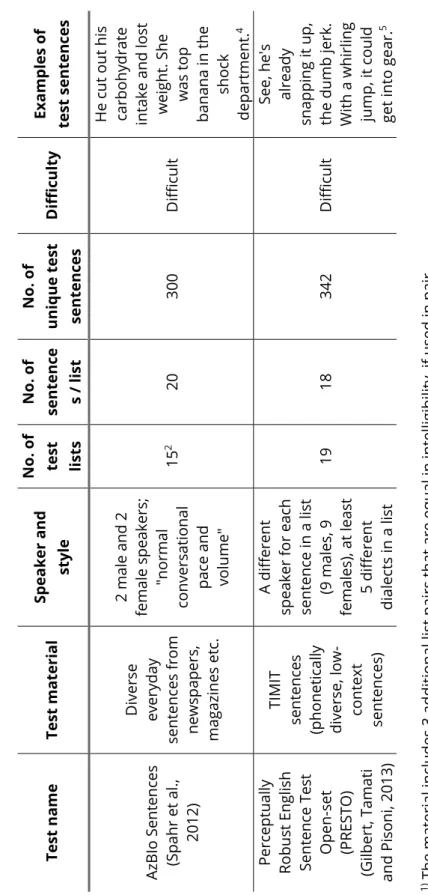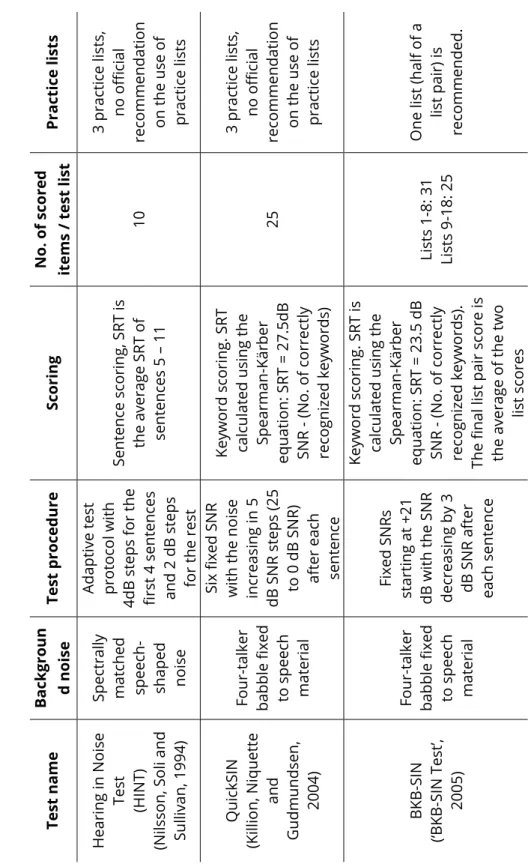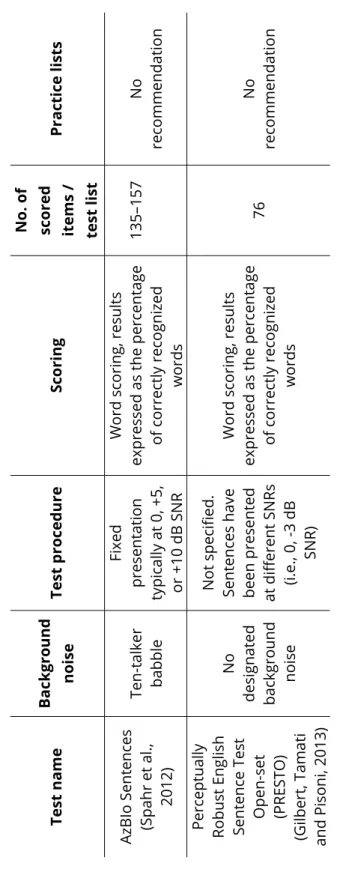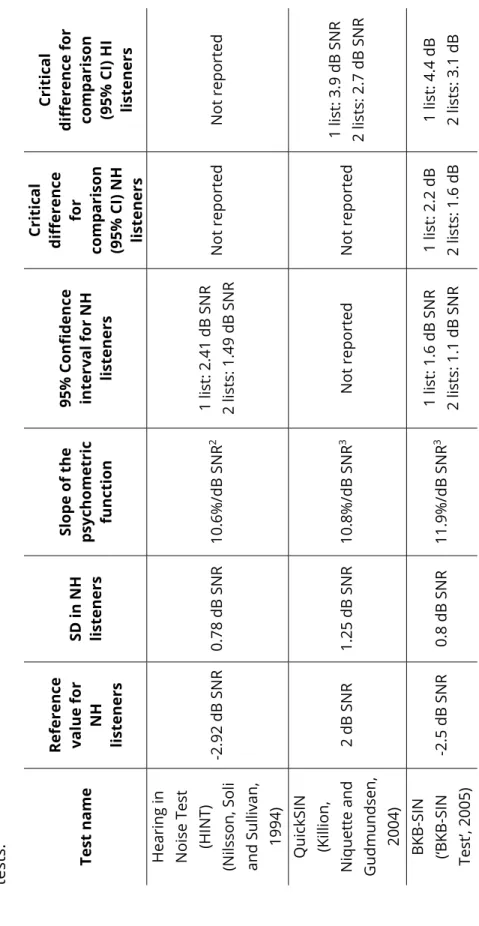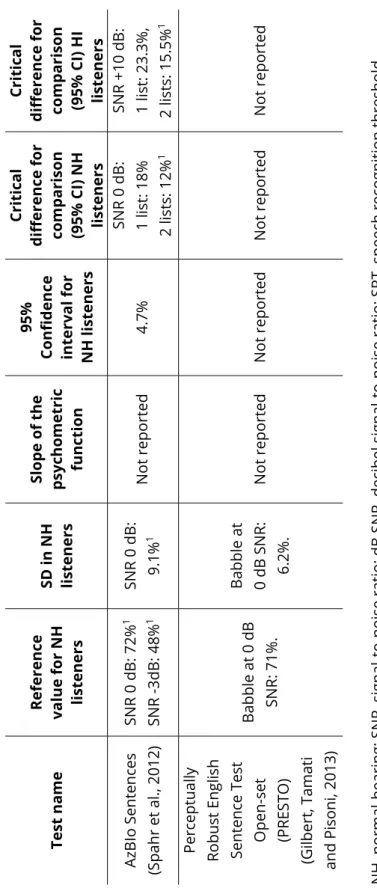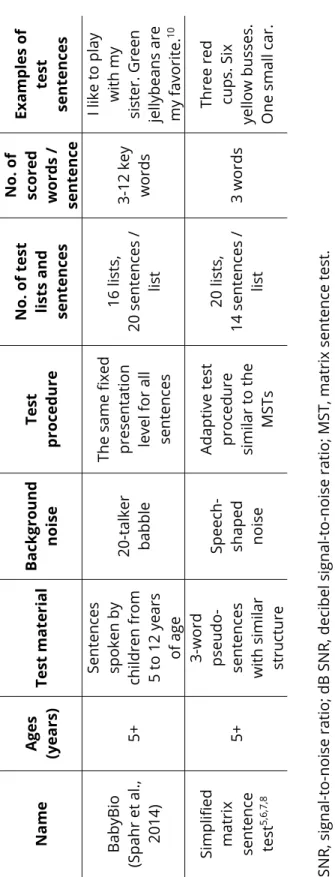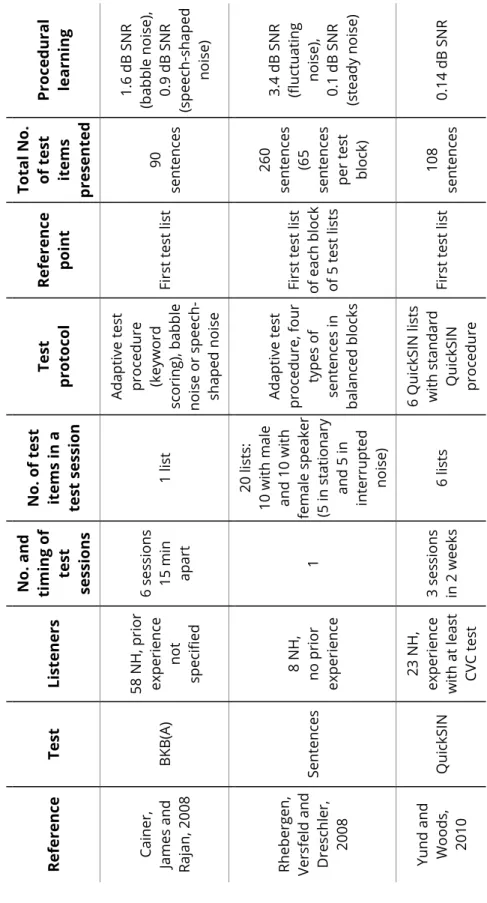Speech perception in noise tests provide a better measure of functional hearing in noise, and are therefore. The Finnish Matrix Sentence Test (FMST) has been the standard speech perception test in noise in Finland since 2014.
Word-level speech perception tests
The test material was used to determine both SRT and speech intelligibility in silence. In the past, an SRS in silence was considered a valid estimate of a listener's speech perception.
Digits as speech test material
- The anatomy of a DTT
- Comparability to other hearing measures
- DTTs in hearing screening
- DTTs in monitoring hearing rehabilitation results
- The future of DTTs
Kaandorp et al., 2015) reported only a moderate correlation (r = 0.56) between a sentence-level speech perception test in noise and the DTT. Broadband versions of DTT have been used successfully for screening for noise-induced HL (Jansen et al., 2013).
Sentence-level speech perception tests in noise
Tests with everyday sentences as test material
Some tests (AzBio (Spahr et al., 2012)) use the same fixed presentation level throughout the test and present results as a percentage of correct responses. A certain level of presentation predisposes to floor or ceiling effects (ie, the test is too difficult or too easy), especially if the same test material is used to assess hearing before and after rehabilitation (Gifford, Shallop, & Peterson, 2008; Dornhoffer et al., 2021).
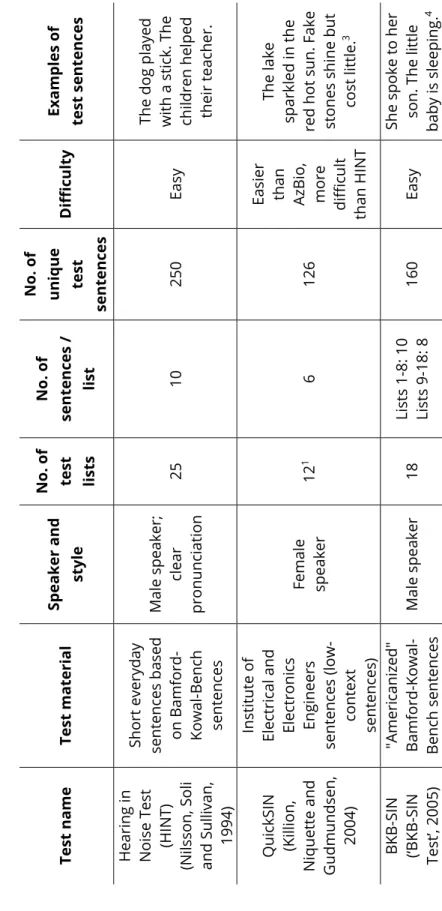
Matrix sentence tests
The test-retest difference has been reported to be typically lower than 1 dB SNR (Kollmeier et al., 2015). During the test, the word matrix is not available and the listener has to repeat the words they hear.
The effect of age on testing speech perception in noise
- Speech perception in noise in children
- Testing sentence-level speech perception in noise in
- Speech perception in noise in the elderly
- Testing sentence-level speech perception in the noise in the
Walker et al., 2019) and Magimairaj and Nagaraj (Magimairaj and Nagaraj, 2018) did not find any relationship between working memory and speech perception in noise. Variation in onset and severity of age-related HL is large (Hoff et al., 2020;.
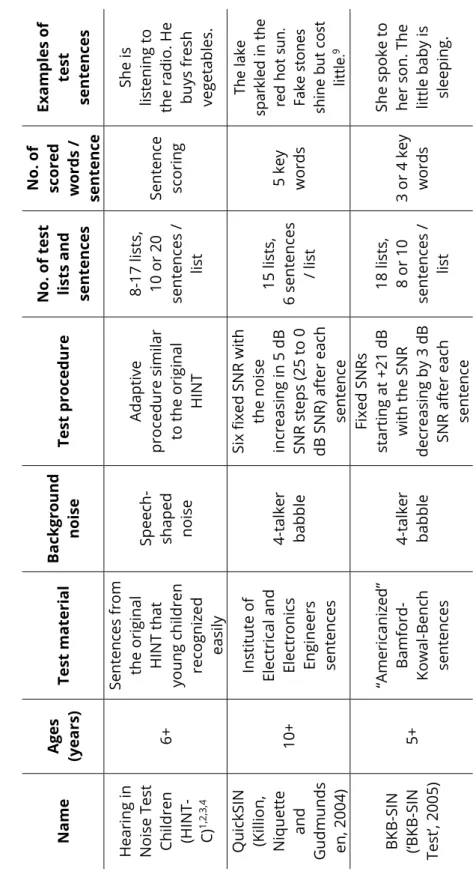
Learning effect related to repeated speech perception testing
Perceptual learning
Auditory perceptual learning can be defined as an enhanced ability to detect, distinguish, or categorize sounds or sound features (Halliday et al., 2012). Some studies of the repeated use of speech intelligibility tests have interpreted the improvements in test results as perceptual learning (Cainer, James, and Rajan, 2008; Bugannim et al., 2019).
Test-retest difference
Procedural learning
Although the test material may be new to the participant, prior familiarity with the psychoacoustic test procedures may affect the amount of procedural learning. The HINT (Nilsson, Soli, & Sullivan, 1994) is one of the most well-translated tests of speech perception in noise, and also has the most evidence of procedural learning.
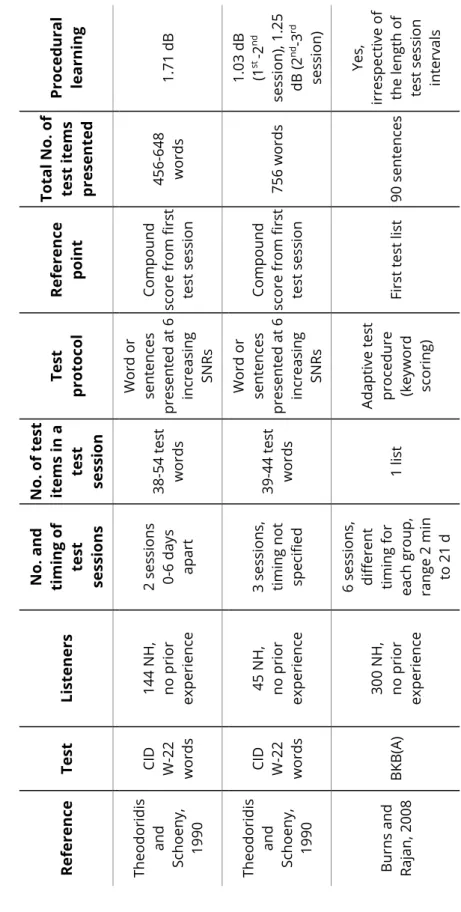
Content learning
The amount of content learning is likely related to exposure to the speech material. Adaptive testing procedures typically converge to the SNR, recognizing 50% of the test material correctly.
Learning effect in the elderly and in children
The pediatric versions of speech perception tests in noise have fewer test lists than the original versions (Wagener and Kollmeier, 2005; the overall aim of this thesis was to expand the Finnish speech audiometry test battery and improve the reliability of the new and current Finnish speech perception tests in noise .
Abstract
The text corresponds to the original Accepted Manuscript except for the heading numbers for figures and tables, which have been changed. Also the font and the references have been formatted to match the general format of this thesis.
Introduction
The basic concept of the DTT uses digit triplets (for example 2-4-7, pronounced two-four-seven) as speech material and adaptive up-and-down tracking for the SRT determination. The success of the early versions of the DTT led to the development of similar tests in different languages (Zokoll et al., 2012; Akeroyd et al., 2015).
Material and Methods
- Recording of the speech material
- Cutting the speech material and re-synthesizing the
- Development of the masking noise
- Participants
- Optimization
- Evaluation measurements
The equipment and setup were the same as in the optimization of speech material for the Finnish matrix sentence test (Dietz et al., 2014). At the beginning of the session, each subject performed two training lists in an adaptation procedure.
Results
Results from the optimization measurements
The purpose of the evaluation measurements was to obtain a normative reference function for normal-hearing listeners and to verify that there was no systematic difference in intelligibility between the final test lists. The order of test lists and SNRs used was randomized to minimize the effect of training or fatigue on the results.
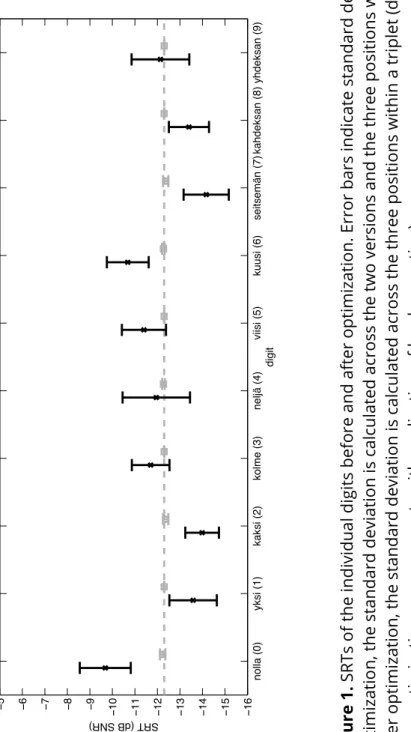
Results from the evaluation measurements
The crossed and solid horizontal black lines indicate the mean plus/minus one standard deviation of the adaptively determined SRT. As expected, the digit score resulted in a slightly flatter mean slope of dB for all subjects.
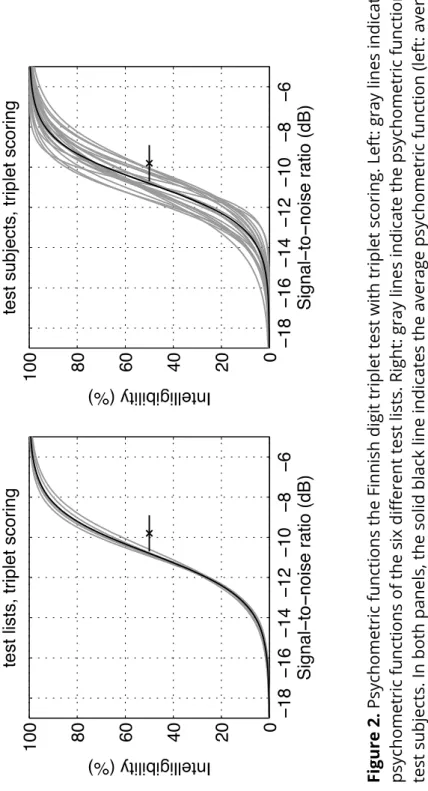
Discussion
For the Finnish version, all digits 0 to 9 were used because after optimization no large differences in intelligibility could be measured (see Figure 1). For the Finnish tests, however, the difference between the reference SRTs is very small (see Table 8).
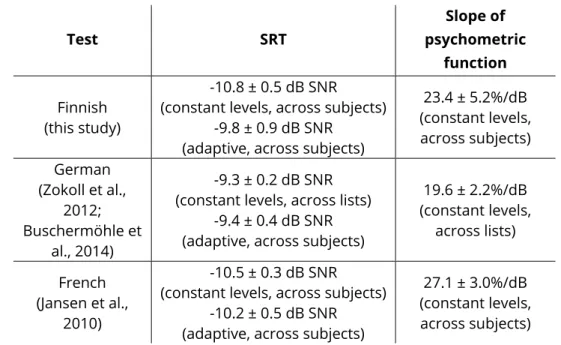
Conclusions
This predictability may contribute to the apparently better comprehensibility (i.e., lower SRT) of the Finnish version of the matrix test and explain the similarity of the reference SRTs for the Finnish DTT and the matrix test. 5 THE FINNISH SIMPLIFIED MATRIX TEST FOR THE ASSESSMENT OF SPEECH INtelligibility IN THE ELDERLY.
Abstract
For older HI listeners, mean SRT50 scores for FINSIMAT and FMST were −4.1 and −3.6 dB SNR, respectively. Conclusion: The FINSIMAT showed comparable characteristics to the FMST and proved feasible for measurements in older HI listeners.
Introduction
Since the most widely used and the only internationally comparable diagnostic speech intelligibility test in noise in the Finnish language is the Finnish matrix sense test (FMST) (Dietz et al.), it was logical to base the new test on the FMST. , the OLKISA was found to be more appropriate than the OLSA when testing normal hearing (NH) children aged 6-8 (Wagener and Kollmeier, 2005) and considered appropriate for HI children in noise and in silence (Ebner, Steffens, and Hellbrück, 2008 ; Weissgerber et al., 2012).
Study 1: The development and evaluation of the Finnish
Materials and Methods
The word matrix of the Finnish matrix sentence test (FMST), adapted from (Dietz et al. 2014). The words in bold are also included in the word matrix of the Finnish Simplified Matrix Sentence Test (FINSIMAT).
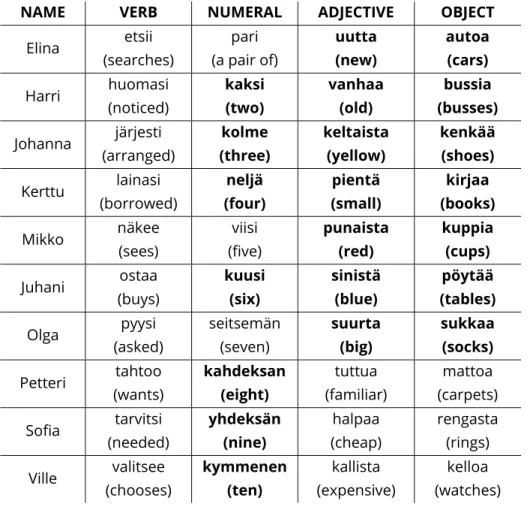
Results
The speech intelligibility functions of the Finnish Simplified Matrix Sense Test (FINSIMAT) are derived from the evaluation measures in Study 1 with normal hearing young adults. The list-specific speech intelligibility functions of the Finnish Simplified Matrix Sentence Test (FINSIMAT) are derived from the evaluation measures in Study 1 with normal-hearing young adults.
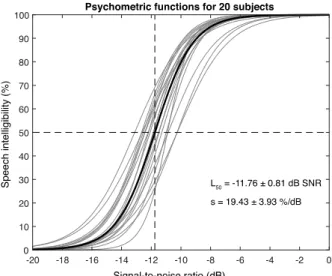
Study 2: Evaluation of the FINSIMAT in the Elderly
Materials and Methods
Independent sample t-test was used to assess differences between ears, and paired sample t-test was used to assess the possible differences between the ear-specific FINSIMAT and FMST results. Pearson's correlation coefficient was used to assess the correlation between the FMST and FINSIMAT results.
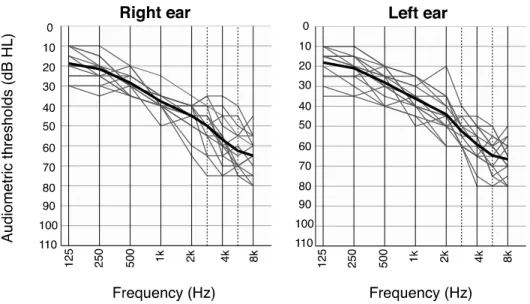
Results
The correlation between the two tests was good (r2 = 0.78, p < 0.001) as depicted in Figure 8, where the results for both tests are shown for each participant. Correlation between Finnish Matrix Sentence Test (FMST) and Finnish Simplified Matrix Sentence Test (FINSIMAT) results in elderly hearing-impaired patients in Study 2.
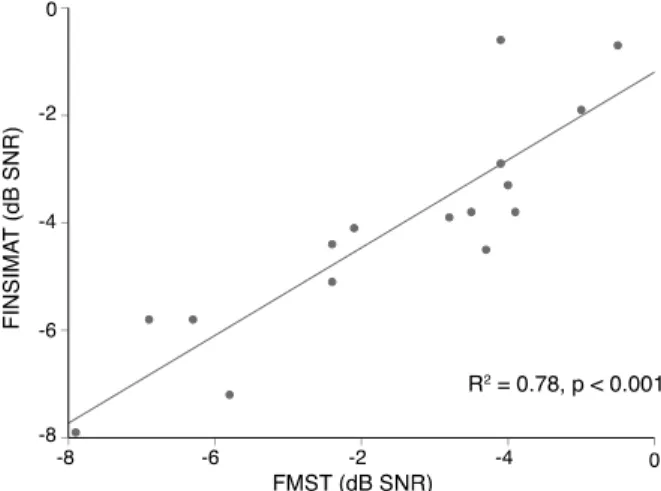
Discussion
Most of the improvements to the SRT80 rating were made during the first two adaptive measurements, and after these measurements. However, the first measurement for SRT50 estimation was preceded by four training measurements with the FINSIMAT test material.
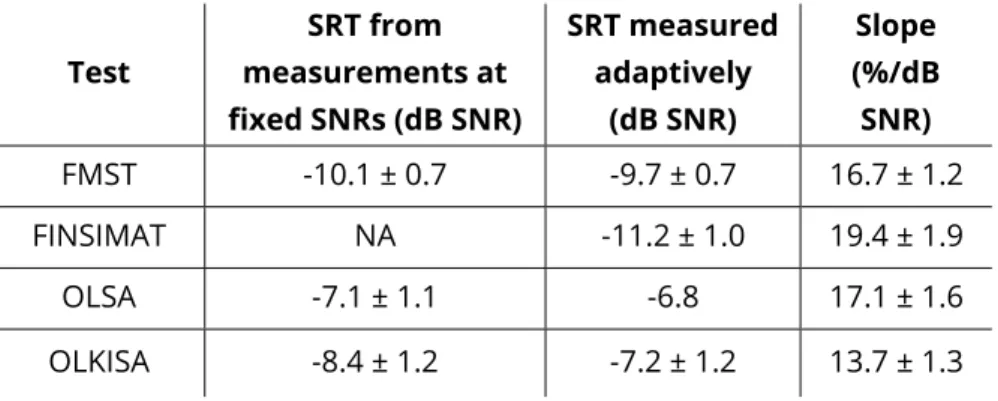
Conclusions
6 THE LONG-TERM LEARNING EFFECT ASSOCIATED WITH THE REPEATED USE OF THE FINNISH MATRIX TEST AND THE FINNISH NUMBER. This chapter is fully derived from the Accepted Manuscript of an article published by Taylor & Francis in International Journal of Audiology at available at: https://doi.org The text corresponds to the original Accepted Manuscript except for the heading numbers for figures and tables, after which have been changed.
Abstract
Conclusions: Repeated use of the FMST led to significant learning-related improvements, but improvements appeared to level off by the third test session. For the FDTT, overall improvements were smaller, but there was a significant difference between the first and consecutive FDTT measurements between test sessions.
Introduction
Content learning refers to improvement through familiarity with the test material and benefiting from memory of parts of the test material from previous test sessions. A training effect, attributed to both content and procedural learning, has been reported for different versions of the test.
Materials and methods
- Participants
- Apparatus
- Procedure
- Data Analysis
In the test, the numbers 0-9 are combined into quasi-random triads (i.e., 2-6-4, pronounced two-six-four) and presented against background noise with a preceding announcement phrase "Numerot..." ("The numbers… ”). All measurements were performed in a sound field chamber in the S0N0 condition, i.e. the signal and noise were presented by the same loudspeaker at 0° azimuth in the horizontal plane.
Results
FMST Results
The average washout effect between sessions was assessed by comparing M1 scores with M4 scores from the previous test session. FMST scores from the last test session were compared with the number of words participants correctly recalled from the FMST word matrix.
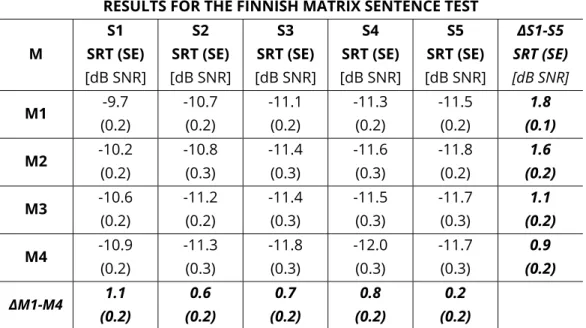
FDTT Results
However, the amount of statistically significant differences quickly decreased, and between the last three test sessions (S3, S4, and S5), a pairwise comparison of SRT scores detected only three statistically significant differences (S3M1-S3M4, S3M1-S4M4, and S4M1). -S4M4). All statistically significant differences for the last three test sessions were detected only when compared to the first adaptive measurement of the test session, which is considered a training measurement according to the current recommendation for clinical use of the FMST.
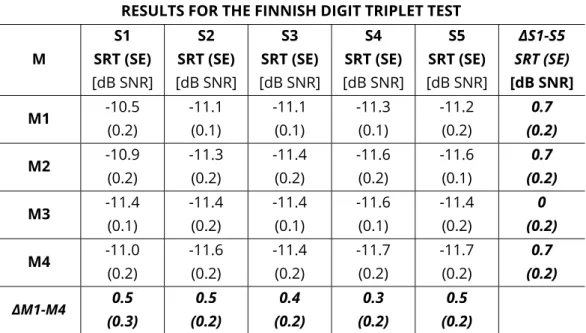
Discussion
- Within-Session Learning Effect for the FMST
- The Long-Term Learning Effect for the FMST
- Learning Effect for the FDTT
- Procedural Learning
- Content Learning
- Comparison of the long-term learning effect between
- Learning effect for hearing-impaired patients
- Limitations
In both studies, the results of the last test measurements (the mean of the 5th and 6th test measurements) of the first and the last (5th) test session were compared, and in both studies the improvements were greater than in our data ( Table 13) . However, even with part of the procedural learning eliminated, the learning effect for FMST was both clinically and statistically significant and greater than the learning effect for FDTT.
Conclusions
American Speech-Language-Hearing Association, pp. 2014) 'The development and evaluation of the Finnish Matrix sentence test for speech intelligibility assessment', Acta Oto-Laryngologica, 134(7), pp. Neurotology: Official Publication of the American Otological Society, American Neurotology Society [and] European Academy of Otology and Neurotology, 37(2), pp. 2017) 'Prevalence of age-related hearing loss,.
General discussion
Development of the Finnish digit triplet test (Study I)
Development of the FDTT started in 2014, and between then and writing this, interest in DTTs and the available research data on them has exploded (for a recent review, see (Van den Borre et al., 2021). current multicultural world , speech audiometry must accommodate the different language skills of the listeners.
Development of the Finnish simplified matrix sentence test
Evaluation of long-term learning effects (Study III)
We assumed that the learning effect we observed probably represented maximal learning, and that the learning effects could be significantly smaller in a clinically representative patient population. Although the learning effect persisted throughout the study sessions, the improvement leveled off, indicating that the learning effects for MST are limited.
Study limitations and future perspectives
2011) 'Assessment of auditory nonlinearity for listeners with different hearing losses using temporal masking and categorical loudness scaling', Hearing Research, 280(1), pp. 2016) 'The influence of lexical access and vocabulary knowledge on measures of speech recognition in noise', International Journal of Audiology, 55(3), pp. New York, NY: Springer, pp. 2020) 'Cognitive and Linguistic Contributions to Masked Speech Recognition in Children', Journal of Speech, Language, and Hearing Research, 63(10), pp. 2017) 'Individual differences in language and working memory influence children's speech.
